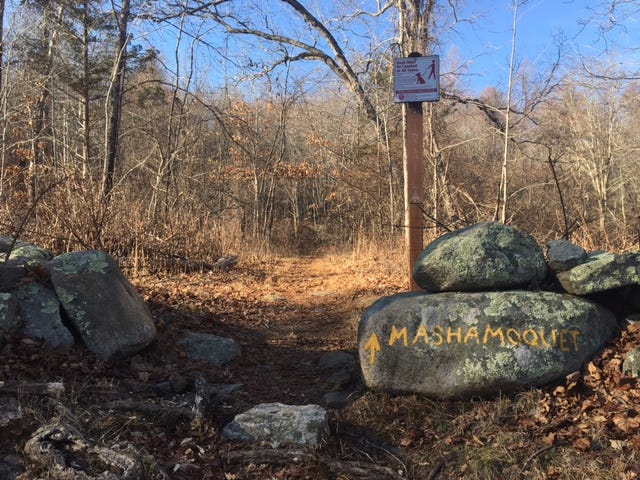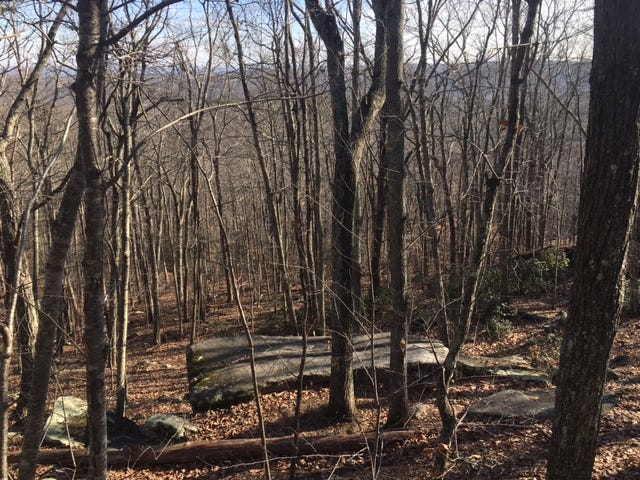Wolves. Silver-haired denizens of the wilderness? The not-so-distant cousins of man’s best friend? Or a snarling, sharp-toothed menace to sheep, chickens, and other farm animals? When it comes to the relationship between humans and canis lupus, “it’s complicated” is putting it lightly. Wolves have appeared in mythology and folklore, often as symbols of strength and courage. But wolves have also been a convenient scapegoat for ecological crises like the decline of the caribou in Canada’s northern tundra. (Carroll Ballard’s criminally overlooked Never Cry Wolf explores this in vivid and eerie detail.) In New England, wolves have been all but eradicated—often at the hands of farmers fed up with losing livestock to the occasional scavenging wolf.
One of those farmers, a Connecticut man named Israel Putnam, is reputed to have shot the last known wolf in the Nutmeg State in 1742. And deep in the rustling wilds at Mashamoquet Brook State Park—an hour’s drive from Hartford or Providence—you can follow a spiderweb of stony paths to the hillside cave in which this ecological tragedy took place. This haunting, desolate historic site is known as the Wolf Den.
I think it’s safe to assume consensus that anyone thumping their chest about having killed the last wolf in an entire state is A: a pompous ass, and B: not someone whose word should be taken at face value. But neither of these things stopped the Wolf Den from becoming a tourist attraction during the 19th Century. The opening of the narrow slot-like cave is paired with a weathered plaque that tells the story of Israel Putnam and his quest to take down the wolf that had killed several of his sheep and goats—and resisted prior assassination efforts. After a particularly hefty livestock loss, Putnam and his bloodhounds chased the wolf across the winter landscape. Once they had cornered the wolf and driven it into the cave, Putnam fashioned a torch from birch bark, crawled into the dank passageway with his gun, and fired. He dragged the wolf carcass out by the ears, cementing his place in Connecticut history and folklore.
Today, the Israel Putnam Wolf Den is not exactly something that the Connecticut tourism office highlights, for understandable reasons. It’s more like one of those weirder, darker Springsteen deep cuts that would feel out-of-place at a Madison Square Garden show but is beguiling and powerful in its own right, for those who manage to seek it out. There are multiple ways to hike to the Wolf Den through Mashamoquet Brook State Park’s sun-splashed woods and abundant laurel plants.
But for a particularly robust and environmentally diverse hike, you’ll want to head for the park’s north entrance off Route 44 and pick up the trail marked with blue blazes, which begins by a bridge over Mashamoquet Brook itself. This admirably rooty and rocky 4.2-mile loop hike skirts the boundaries of the park, crossing plenty of soggy spots on bog bridges and occasionally popping out into meadows and campgrounds.
While you can reach the Wolf Den by hiking in either direction, embarking on the blue trail counter-clockwise from the park’s north side will give the hike more of a scenic escalation effect. As the trail heads south along the park’s easternmost woods and wetlands, the trees begin to part just wide enough to reveal views of the surrounding hills and valleys. These views are actually better during the winter, when the branches are mostly free of leaves. And as you start to cross the park’s southern terminus on an elevated stretch of trail, you’ll start to notice an impressive collection of glacial boulders and rock formations in the vicinity. One of them resembles an armchair, the sort of furniture on which you’d savor a brandy or a punishing novel like Jude The Obscure, and keeping with the park’s theme of Oddities That Haven’t Aged Well, this rock formation is called Indian Chair. Take a seat, unwrap a KIND Bar, and ruminate.
The Wolf Den itself isn’t far from the chair, and to get there, you have to climb a bunch of raggedy stone stairs wedged into the wooded hillside. Whether it’s the plaque that catches your eye, or the little black hole in the exposed rock, the Den is impossible to miss. If other hikers are in the vicinity, there’s a good chance you’ll see someone in the process of photographing the Wolf Den or trying to shimmy into the cave themselves.
I thought about doing this when I arrived here, even without the benefit of a birch bark torch. But it wasn’t the thought of getting stuck that kept me standing by the entrance to the Wolf Den. It was a sense of humility—of wanting to see this space decoupled from the folklore and slowly re-assimilated by the land. The weathering of the plaque beside the entrance warmed my heart a little bit. It was a balm for the sadness of this place to see time and natural elements visibly chipping away at the literal words of Israel Putnam’s story. This might not bring the wolves back to Connecticut, but might not are the important words here. Because who knows what the primacy of mankind will look like over the next few centuries? Especially as climate change redraws the boundaries between civilization and wilderness, bringing the natural world into our streets, backyards, and even our homes. Back in 2012, a moose somehow clomped its way to the gilded burbs of Wellesley, Massachusetts. Imagine if others followed.
Still, the narrative of the most recent centuries is one of great loss in the natural world. The Wolf Den is an essential pilgrimage for hikers looking to remember the denizens of the New England woods, driven away by agriculture and capital. And on that note, here’s a closing song by the great Don Edwards, which I first heard in Werner Herzog’s documentary Grizzly Man. Cue it up for the drive home, wherever it is you’re heading.
The Wolf Den via the Blue Trail (sometimes called the Mashamoquet Brook Trail)
Hike distance: 4.2 miles loop
Elevation gain: 748 feet
CLICK HERE for a state park trail map
or CLICK HERE for an AllTrails trail map
And here's the audio version of this week's newsletter:






